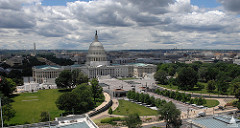The Senate's Version of FY 2018: NASA, NSF, and DOE
Heather Bloemhard Vanderbilt University

The Senate Appropriations Committee has passed their version of the Commerce, Justice, Science (CJS) and Energy & Water (E&W) fiscal year (FY) 2018 Appropriations bills. These bills appropriate funds for NASA, the National Science Foundation (NSF), and the Department of Energy (DOE), as well as several other agencies. We summarize the Senate'e funding levels for NASA, NSF, and DOE below and, where possible, make comparisons to the President's FY 2018 Budget Request. You can read about the President's Request and the House versions of these budgets in previous blog posts.
The next step for these bills is consideration by the full Senate; ditto for the House versions. Assuming that the House and Senate each pass their version of the bills, then they will begin to "conference," to negotiate through the differences. The fact that the House and Senate also need to pass a Budget Resolution could alter the way all of this proceeds. See the previous post on the budget resolution and the AAAS page on The Federal Budget Process (The Congressional Process) for more information.
The table below summarizes the funding levels for NASA's Science Mission Directorate, NSF, and DOE's Office of Science, in millions of US dollars.
|
Account |
FY 2016 Operating Plan | FY 2017 Omnibus | FY 2018 Request | FY 2018 House | FY 2018 Senate |
| NASA | $19,285 | $19,653.3 | $19,092.2 | $19,871.2 | $19,500 |
| Science Mission Directorate | $5,589.4 | $5,765 | $5,711.8 | $5,858.5 | $5,571.8 |
| Earth Science | $1,921 | $1,921 | $1,754 | $1,704 | $1,921 |
| Planetary Science | $1,631 | $1,846 | $1,929.5 | $2,120 | $1,612 |
| Astrophysics | $762.4 | $750 | $816.7 | $822 | $816.7 |
| Heliophysics | $650 | $678 | $677.8 | $677.9 | $688.5 |
| SMD's STEM Activation | [$37] | [$37] | [$44] | [$44] | [$44] |
| JWST | $620 | $569.4 | $533.7 | $533.7 | $533.7 |
| National Science Foundation | $7,463.5 | $7,472.2 | $6,652.9 | $7,339.5 | $7,300 |
| Research & Related Activities (R&RA) | $6,033.6 | $6,033.6 | $5,361.6 | $6,033.6 | $5,918 |
| Major Research Equipment & Facility Construction (MREFC) | $200.3 | $209 | $182.8 | $77.8 | $182.8 |
| Large Synoptic Survey Telescope (LSST) | $99.67 | $99.67 | $57.8 | $57.8 | $57.8 |
| Daniel K. Inouye Solar Telescope (DKIST) | $20 | $20 | $20 | $20 | $20 |
| Department of Energy (DOE) | $29,602.7 | $30,786 | $28,042 | $29,888 | $31,967 |
| Office of Science | $5,347 | $5,392 | $4,472 | $5,392 | $5,500 |
| High Energy Physics | $795 | $825 | $673 | $700.6 | $860 |
NASA Science Mission Directorate (SMD)
|
Account |
FY 2016 Operating Plan | FY 2017 Omnibus | FY 2018 Request | FY 2018 House | FY 2018 Senate |
| NASA | $19,285 | $19,653.3 | $19,092.2 | $19,871.2 | $19,500 |
| Science Mission Directorate | $5,589.4 | $5,765 | $5,711.8 | $5,858.5 | $5,571.8 |
| Earth Science | $1,921 | $1,921 | $1,754 | $1,691 | $1,921 |
| Planetary Science | $1,631 | $1,846 | $1,929.5 | $2,105 | $1,612 |
| Astrophysics | $725.4 | $731.5 | $772.7 | $812 | $772.7 |
| Heliophysics | $650 | $678 | $677.8 | $672.8 | $688.5 |
| SMD's STEM Activation | [$37] | [$37] | [$44] | [$44] | [$44] |
| JWST | $620 | $569.4 | $533.7 | $533.7 | $533.7 |
Planetary Science
Astrophysics
Heliophysics
National Science Foundation
The subcommittee calls out the importance of NSF supported astronomical facilities and indicates that the NSF should "continue its support of world-class scientific research facilities and instrumentation to maximize its investments in research," exploring partnerships when feasible. The Green Bank Observatory (GBO) is specifically called out in the NASA section of the report. The subcommittee encourages NASA "to continue its use of GBO to support its Planetary Science Research program, including orbital debris monitoring activities."
The NSF Division of Astronomical Sciences (AST) has two new facilities being constructed through Major Research Equipment & Facility Construction (MREFC): the Daniel K. Inouye Solar Telescope (DKIST) and the Large Synoptic Survey Telescope (LSST). The Senate CJS Subcommittee supports DKIST and LSST at the request level. The Senate CJS Subcommittee includes three Regional Class Research Vehicles (RCRVs) for Oceanography.
DOE-Office of Science
Additional Information
- SpacePolicyOnline: Senate Appropriations Subcommittee Approves $19.5 Billion for NASA
- SpaceNews: Senate restores funding for NASA Earth science and satellite servicing programs
- AIP FYI's Federal Science Budget Tracker provides up-to-date information on the status of budgets and appropriations relevant to the physical sciences.
- AAAS's R&D Budget Dashboard provides information about science and technology appropriations for a wider range of agencies.

